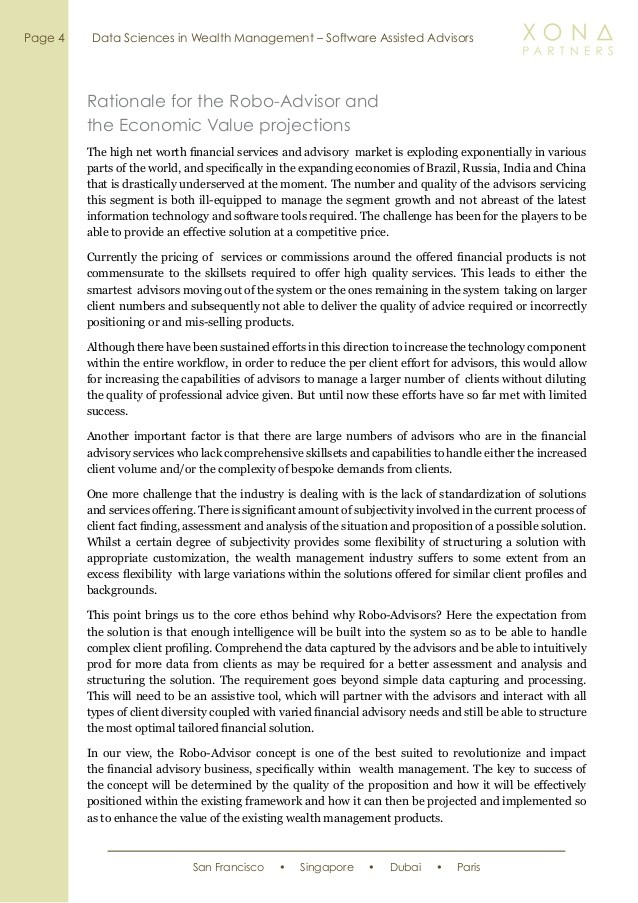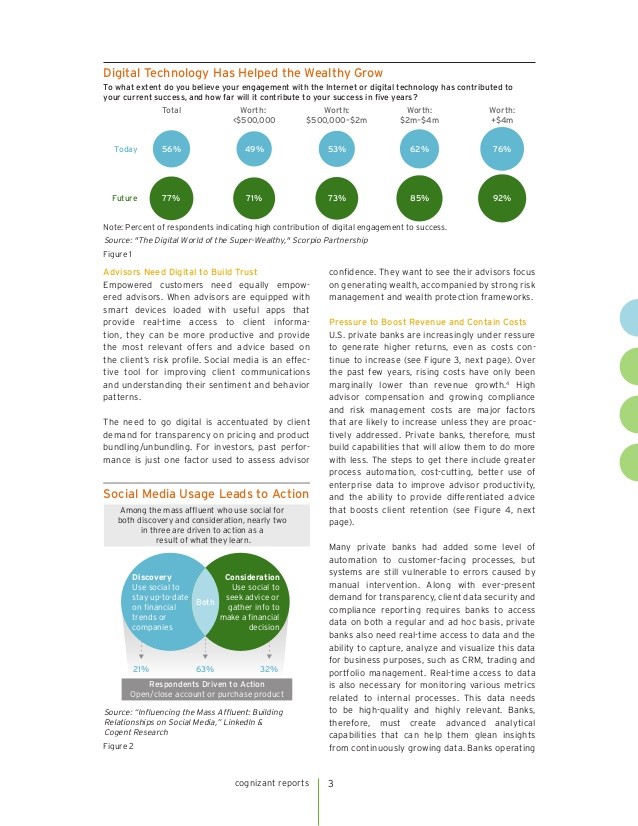How To Pick A RoboAdvisor In The Digital Wealth Management Era
Post on: 10 Май, 2015 No Comment

One of the reasons why Im an Apple user is because I appreciate good service. When I dropped my Macbook one evening and my hard drive stopped working, it was incredibly easy to schedule an appointment with the Genius Bar at my local Apple store. They fixed my hard drive and recovered my data within 30 minutes and away I went. Peace of mind is worth the premium, which is why Im a fan of technology-assisted financial advisory firms with human financial advisors .
But what if you have time and know how to upgrade your RAM, swap out your hard drive, and do your own diagnostics? (I remember doing all that as a teenager.) Then going the robo-advisor route may very well be a good option because their fees are even lower. Theres just no person to guide you through lifes myriad changes.
Robo-advisors, aka algorithmic advisors deploy sophisticated investment algorithms to help invest your money in the best risk-adjusted way possible. You essentially fill out a profile about yourself and the algorithm will go to work to recommend and implement their recommendations for you.
I used to have a hard time trusting computers to do anything for me. But after spending 13 years covering some of the largest mutual funds and hedge funds in America, its clear that algorithmic investing, or more commonly known as quantitative investing or scientific investing have done extremely well. For example, Bridgewater Associates run by Ray Dalio is the largest hedge fund in the world with over $120 billion dollars and its a macro quantitative fund with tremendous performance. Famous hedge funds run by George Soros, David Tepper, and Steve A. Cohen cant even compare.
A good quant fund or algorithmic advisor is all about having good people. At the end of the day, the investment variables are created by people and continuously tested for maximum returns. Spending time understanding peoples backgrounds and then trusting them to do the right thing is a huge part of letting other people run your money. After all, the reason why you want someone else investing your money is because your expertise lies elsewhere, and youve got more interesting things to do with your time.
In this article, Id like to provide a brief primer on the three main robo-advisors that exist today: FutureAdvisor, Betterment, and Wealthfront. Because Ive personally met Bo Lu, Founder of FutureAdvisor. Im going to compare and contrast FutureAdvisor to the other two. They are all based here in San Francisco.
Target-Date Fund Investing
The core offering by robo-advisors is very similar to investing in a target-date fund. A target-date fund works by taking your desired retirement age (without taking into account risk appetite), and slowly shifting your stock/bond split more heavily to bonds as you approach your retirement date.
Wealthfront and Betterment need investors to transfer over their assets in order to create those target-date fund accounts, and they can only see the assets they hold. Once you give them your assets, they allocate them to create a balanced portfolio, but only within that account. Thats a valuable service, but for investors with multiple accounts already, it may not be the right solution.
Wealthfront charges 0.25% of your assets, Betterment charges up to 0.35% and FutureAdvisor is free if you want to DIY or charges 0.5% of your assets to manage your money. Vanguards target-date funds charge 0.17%. The expense ratio for Wells Fargo’s index-based target-date funds ranges from an average of 0.35% to 1.63% per year. For the two classes of Fidelity’s actively managed Freedom funds, the average annual expense ratios are 0.57% and 0.60%.
A Top Down View Of Your Overall Finances
In order to get a balanced recommendation for your investment portfolio, its important for the robo-advisor to see what your overall financial picture looks like. For example, lets say you own a lot of real estate like I do (
35% of my net worth). It doesnt look like you can input such assets to be considered in Betterment and Wealthfronts investment algorithms. They can only provide recommendations on what you give them.
If you believe in modern portfolio theory, then you have to assume that combining Betterment or Wealthfront with external assets will lead to an unbalanced overall portfolio, and investors will pay the price in risk or rewards.
Furthermore, more sophisticated investors with several accounts may not want to liquidate their accounts for a target-date fund. It involves paperwork, the transactions will be taxed, and moving your assets to a startup implies a certain risk.
HOW FUTUREADVISOR IS DIFFERENT
FutureAdvisor goes to your assets, wherever they are, instead of you having to bring your assets to them. This is a huge competitive advantage and selling point in my mind because I dislike paperwork and the process of transferring assets.
FutureAdvisor works with thousands of brokerage accounts and IRAs to provide free financial advice. They provide step-by-step instructions showing you what to buy and sell across all your accounts to achieve a risk-adjusted balanced portfolio.
Wealthfront and Betterment dont offer that free and actionable advice, and they cant see assets outside of the accounts you create with them.
FutureAdvisors premium service will balance your portfolio for you based on the recommendations its algorithm produces. In other words, if you become a client (minimum is $10,000) they will execute your trades for free, which is included in their 50 bps annual fee based off your assets.
FutureAdvisor can directly manage accounts held at Fidelity and TDAmeritrade because they have partnerships with both. Fidelity and TDAmeritrade have millions of accounts and run over a trillion dollars in assets. Chances are you already work with one of them. I had my 401k with Fidelity for 13 years until I rolled it over to a Rollover IRA. Fidelity also holds my SEP IRA and solo 401k as well. Having easy transitions when it comes to someone managing your money is huge.
Wealthfront and Betterment need your assets to go to their algorithms. FutureAdvisor sends its algorithms to your assets. The difference is convenience.
DEEPER TAX-LOSS HARVESTING
All three services do tax-loss harvesting, but they do it in different ways. Betterment and Wealthfront conduct tax-loss harvesting on the assets youve given them from the moment you create an account. They handle future losses.
Because FutureAdvisor can handle all your assets where they are, they conduct tax-loss harvesting on all your losses historically, which can amount to a much larger amount that you can deduct from your taxes.
Accounts at any other brokerage can be moved to Fidelity or TDAmeritrade without a tax hit. Its called a transfer in kind , and it means you dont have to sell what you have and buy something else. This approach logically seems better since it looks at your overall wealth.
FREE 401K ADVICE
Since none of the robo-advisors can actively manage money in a 401k, the majority just ignore it. FutureAdvisor, on the other hand, looks at your entire portfolio holistically. They manage around your 401k with the assets you choose to give them, and also show you how to cut fees and rebalance within your portfolio (without charging on the assets in the 401k). It’s the extra step that makes sure you have a fully diversified portfolio – not just a single diversified account.
Given that 401(k)s account for most of Americans retirement savings. FutureAdvisors ability to work with them makes it much more valuable.
THE TYPICAL FUTUREADVISOR CLIENT
After speaking with Bo (CEO), I discovered that the average FutureAdvisor client has saved more than $100,000. They already have brokerage accounts and IRAs, and they dont want to liquidate them. They want someone who will tell them how to invest better given what they have. This is where FutureAdvisors algorithms come in.
After you create an account with your email. FutureAdvisor provides you with a target portfolio based on your age, retirement year and risk tolerance. In the following slides, Ill show you exactly what I went through so you can get a better idea of the robo-advisory process.
Section #1: Info Gathering
Simply fill out your basic information so that FutureAdvisors algorithms can formulate a plan. Be as honest as possible, because quality outputs depend on quality inputs.
Section #2: Interactive Score Card

After youve filled out your basic info, you link your current investment accounts to get an interactive score card, with step-by-step instructions on how to change your current portfolio to reach your objectives. You get instructions for each account, and an explanation of why theyre suggesting what. Its all about customization based on your own risk-tolerance and input variables.
Section #3: Specific Recommendations
The slide below shows the specific recommendations from FutureAdvisors algorithms instead of more general recommendations. I really like how they go through each security and analyze what you should do and why. If youre a detailed-oriented person like me, this feature is terrific.
Section #4: The Results
The final chart shows exactly how FutureAdvisor will convert your suboptimal portfolio into an A portfolio across the board immediately. If youre using the free service it can be done whenever the markets are open, if youre using the Premium service the paperwork will take a few business days to complete.
MORE ABOUT THE ALGORITHMS
The algorithms FutureAdvisor have are built on data going back over a 100 years where available. Their back testing has been done in some of the most extreme financial corrections and have held up well so far. For example, for 2014 through the end of June FutureAdvisor is ahead of the S&P 500 by +1.65% for the average FutureAdvisor account. Of course, past performance is not indicative of future results.
FutureAdvisors algorithms seek out commission-free ETFs within your broker to eliminate trading costs. iShares funds trade commission free at Fidelity and TD Ameritrade has 100s of commission free ETFs, as two examples. Since they aren’t trading underlying equities, trading costs are rarely if ever an issue.
FutureAdvisor has a team of seasoned CFAs and PhDs who create and maintain the algorithms as well as an academic council who help inform us of financial developments. Simon Moore, CFA, MBA our Chief Investment Officer is an economics graduate from Oxford University and published author.
CONCLUSION
For the DIY investor, FutureAdvisors free tools and recommendations provide a good second recommendation and sanity check for your investment decisions. A lot of times you might think your level of risk exposure is appropriate with your risk tolerance, but often times youll be wrong. The good thing about an algorithm is that there is no bias. It will unabashedly tell you what it thinks you should do to become better aligned with your objectives. Then its up to you to figure out whether to take its advice or not. Perhaps your investments already have a B or A grade based on their algorithms and you wont have to do much at all. You wont know until you try.
If you don’t want to handle the transactions yourself, FutureAdvisor can manage your money for 0.5% of assets per year with a minimum commitment of $10,000. They automatically rebalance, optimize for taxes and can auto-invest new cash when added. Their goal is to get your Performance, Diversification, Fee Efficiency, and Tax Efficiency all to an A grade. Im sure the other robo-advisors are good as well. But I like to discuss what I know based off the people Ive met.
FutureAdvisor is backed by Sequoia Capital and angel investors which include Keith Rabois, the chief operating officer at Square, and Yelp founder Jeremy Stoppelman. Its a small world because after I played tennis with Bo Lu, the CEO of FutureAdvisor at my club, I played tennis with Jeremy just a couple weeks later and he brought up the fact that he is an early investor in Bos company.














